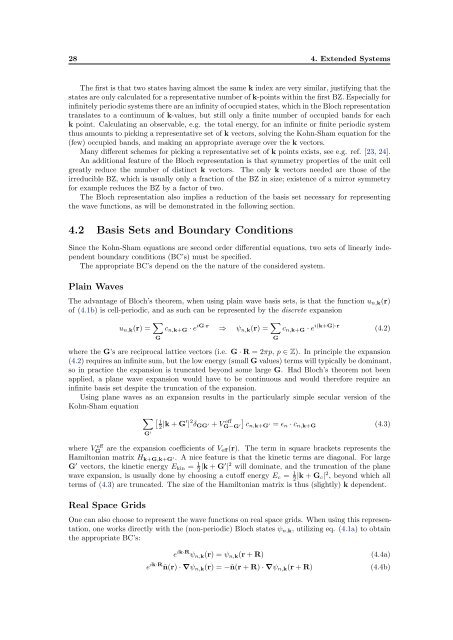Exact Exchange in Density Functional Calculations
Exact Exchange in Density Functional Calculations
Exact Exchange in Density Functional Calculations
You also want an ePaper? Increase the reach of your titles
YUMPU automatically turns print PDFs into web optimized ePapers that Google loves.
28 4. Extended SystemsThe first is that two states hav<strong>in</strong>g almost the same k <strong>in</strong>dex are very similar, justify<strong>in</strong>g that thestates are only calculated for a representative number of k-po<strong>in</strong>ts with<strong>in</strong> the first BZ. Especially for<strong>in</strong>f<strong>in</strong>itely periodic systems there are an <strong>in</strong>f<strong>in</strong>ity of occupied states, which <strong>in</strong> the Bloch representationtranslates to a cont<strong>in</strong>uum of k-values, but still only a f<strong>in</strong>ite number of occupied bands for eachk po<strong>in</strong>t. Calculat<strong>in</strong>g an observable, e.g. the total energy, for an <strong>in</strong>f<strong>in</strong>ite or f<strong>in</strong>ite periodic systemthus amounts to pick<strong>in</strong>g a representative set of k vectors, solv<strong>in</strong>g the Kohn-Sham equation for the(few) occupied bands, and mak<strong>in</strong>g an appropriate average over the k vectors.Many different schemes for pick<strong>in</strong>g a representative set of k po<strong>in</strong>ts exists, see e.g. ref. [23, 24].An additional feature of the Bloch representation is that symmetry properties of the unit cellgreatly reduce the number of dist<strong>in</strong>ct k vectors. The only k vectors needed are those of theirreducible BZ, which is usually only a fraction of the BZ <strong>in</strong> size; existence of a mirror symmetryfor example reduces the BZ by a factor of two.The Bloch representation also implies a reduction of the basis set necessary for represent<strong>in</strong>gthe wave functions, as will be demonstrated <strong>in</strong> the follow<strong>in</strong>g section.4.2 Basis Sets and Boundary ConditionsS<strong>in</strong>ce the Kohn-Sham equations are second order differential equations, two sets of l<strong>in</strong>early <strong>in</strong>dependentboundary conditions (BC’s) must be specified.The appropriate BC’s depend on the the nature of the considered system.Pla<strong>in</strong> WavesThe advantage of Bloch’s theorem, when us<strong>in</strong>g pla<strong>in</strong> wave basis sets, is that the function u n,k (r)of (4.1b) is cell-periodic, and as such can be represented by the discrete expansionu n,k (r) = ∑ Gc n,k+G · e iG·r ⇒ ψ n,k (r) = ∑ Gc n,k+G · e i(k+G)·r (4.2)where the G’s are reciprocal lattice vectors (i.e. G · R = 2πp, p ∈ Z). In pr<strong>in</strong>ciple the expansion(4.2) requires an <strong>in</strong>f<strong>in</strong>ite sum, but the low energy (small G values) terms will typically be dom<strong>in</strong>ant,so <strong>in</strong> practice the expansion is truncated beyond some large G. Had Bloch’s theorem not beenapplied, a plane wave expansion would have to be cont<strong>in</strong>uous and would therefore require an<strong>in</strong>f<strong>in</strong>ite basis set despite the truncation of the expansion.Us<strong>in</strong>g plane waves as an expansion results <strong>in</strong> the particularly simple secular version of theKohn-Sham equation∑ [ 12 |k + G′ | 2 δ GG ′ + VG−G eff ] ′ cn,k+G ′ = ɛ n · c n,k+G (4.3)G ′where VGeff are the expansion coefficients of V eff(r). The term <strong>in</strong> square brackets represents theHamiltonian matrix H k+G,k+G ′. A nice feature is that the k<strong>in</strong>etic terms are diagonal. For largeG ′ vectors, the k<strong>in</strong>etic energy E k<strong>in</strong> = 1 2 |k + G′ | 2 will dom<strong>in</strong>ate, and the truncation of the planewave expansion, is usually done by choos<strong>in</strong>g a cutoff energy E c = 1 2 |k + G c| 2 , beyond which allterms of (4.3) are truncated. The size of the Hamiltonian matrix is thus (slightly) k dependent.Real Space GridsOne can also choose to represent the wave functions on real space grids. When us<strong>in</strong>g this representation,one works directly with the (non-periodic) Bloch states ψ n,k , utiliz<strong>in</strong>g eq. (4.1a) to obta<strong>in</strong>the appropriate BC’s:e ik·R ψ n,k (r) = ψ n,k (r + R)e ik·Rˆn(r) · ∇ψ n,k (r) = −ˆn(r + R) · ∇ψ n,k (r + R)(4.4a)(4.4b)












